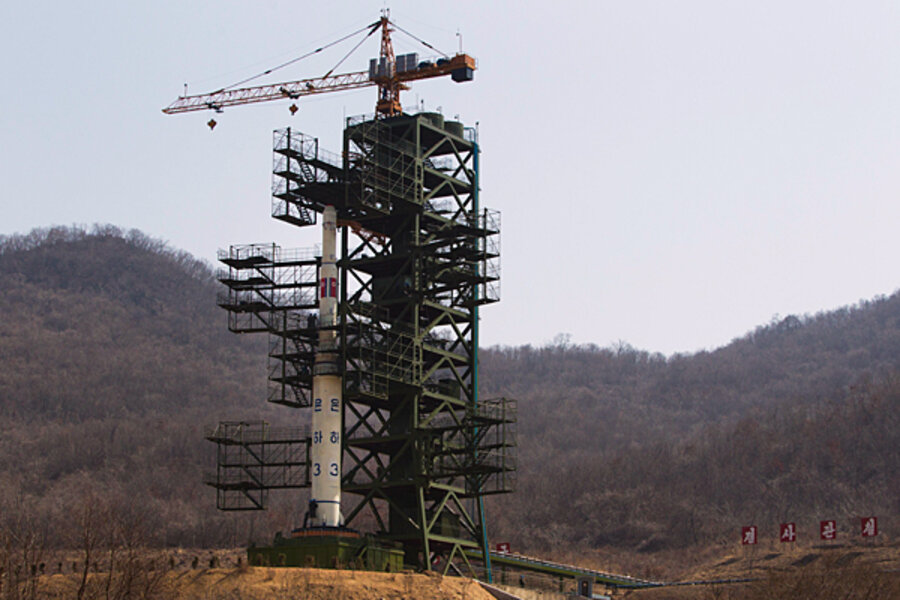North Korea preps for rocket launch despite international warnings
Loading...
| Tokyo
North Korea appears certain to fire a long-range rocket this month in defiance of appeals by friends and foes alike to give up the plan in the interests of regional stability.
In what's widely seen as another intimidating display of military potential, the North has announced it will launch the rocket sometime between Dec. 10 and Dec. 22. North Korea has notified the International Maritime Organization of the anticipated trajectory of the rocket, which will drop its first stage over the Yellow Sea west of South Korea and its second stage near the Philippines, and analysts see little prospect of any change of plans.
The pressure on North Korea’s “supreme leader” Kim Jong-un to assert his authority over military leaders also appears to be a motivating factor, ahead of the first anniversary Dec. 17 of the death of his father, Kim Jong-il. As chairman of the national defense commission, Kim Jong-il had consolidated his power and won the loyalty of generals whom his son has largely replaced amid questions about his real grip over the North's sprawling military establishment.
“Domestically, North Korea wants to promote national solidarity,” says Choi Jin-wook, North Korea expert at the Korean Institute of National Unification in Seoul.
The anniversary of the death of Kim Jong-il seems like a particularly appropriate time in view of the failure of the launch of the same type of missile April 13, two days before the centennial of the birth of Kim Il-sung, the father of Kim Jong-il and grandfather of Kim Jong-un. The missile plunged into the Yellow Sea 90 seconds after the launch.
Undeterred by diplomatic flurry
Diplomatic efforts to dissuade North Korea from the launch have intensified even as satellite imagery shows North Korean engineers and technicians preparing a site in the far northwestern region of the country. Lim Sung-nam, South Korea’s envoy on efforts at dialogue with North Korea, has flown to Washington for talks with US officials that he says are intended “to maximize diplomatic efforts and coordination.”
North Korea appears oblivious not only to protests from the US, South Korea, and Japan, but also to discouraging words from China, its main benefactor and ally, and Russia, which also provides limited amounts of aid.
China, under pressure from the US and others to persuade North Korea to give up the plan, has been extremely circumspect. A Chinese foreign ministry spokesman has said that “all sides” should be careful not to “worsen the problem,” while stressing the need for “peace and stability on the Korean peninsula” and in the region.
Russia’s foreign ministry has been somewhat more direct, appealing to North Korea “to reconsider the decision to launch a rocket.”
The North Korean plan has rekindled memories of the launch of the first Taepodong on Aug. 31, 1998, when the rocket was fired over the main Japanese island of Honshu before landing in the western Pacific.
Japan’s Prime Minister Yoshihiko Noda promptly cancelled plans for long-delayed talks with North Korea that were scheduled for this week, while Japan’s anti-missile system was put on alert with orders to shoot down the North Korean rocket if it flew anywhere over Japan.
Impossible dream?
Before leaving Seoul for Washington, South Korean envoy Mr. Lim told the South Korean news agency Yonhap that the purpose of the talks was “to block North Korea's launch of a long-range missile,” but analysts believe that is an impossible dream.
Victor Cha, director of Asian affairs on the National Security Council during the presidency of George W. Bush, cites factors ranging from the anniversary of Kim Jong-il’s death to the desire to bring pressure on the US to recognize North Korea.
Yet another factor, he believes, may be “wanting to influence” South Korea’s presidential election on Dec. 19 in which the conservative Park Geun-hye, daughter of the dictatorial Park Chung-hee, who was assassinated in 1979, faces the liberal Moon Jae-in. Both Ms. Park and Mr. Moon are sure to want to attempt some form of reconciliation with the North – though Park’s policies would probably be less conciliatory. North Korean strategists may believe Park would be more inclined to compromise if intimidated by a demonstration of the North's success in manufacturing rockets and missiles, including short and mid-range models for firing into South Korea or Japan.
Although Kim Jong-un has replaced a number of top generals, says Mr. Cha, “the external behavior is the same” as during the rule of his father. North Korea has successfully fired two long-range rockets, Taepodong I and Taepodong II, in 1998 and again in 2009. In every case, North Korea insists the purpose is to put a satellite into orbit, but no satellite was detected in any of the previous launches.
North Korea, in announcing plans to launch the rocket this month, claimed to have fixed the flaws that led to the failure of the attempt in April.
“Each of the failures of past launches has been associated with moving from one stage to another,” says Bruce Bechtol, who has written extensively on North Korea’s military buildup. “Acquiring thrust technology may be a factor that increases the chances of a successful three-stage launch.”
Eyeing sales abroad?
Mr. Bechtol also sees a strong profit motive. “This missile – if successfully tested – is likely to be almost immediately proliferated to Iran,” he says. “Sales would likely result in profits in the hundreds of millions of dollars for Pyongyang."
The deepest fear is that North Korea is developing the technology for attaching a nuclear warhead to a long-range missile capable of going as far as Hawaii, Alaska, or the US West coast.
“If you have a missile program,” says David Straub, a former senior US diplomat in South Korea, “you have to test and test again.” Since the last attempt failed in April, he says, “another test was warranted,” and “conducting it around Kim Jong-il’s death probably makes sense in terms of the regime's internal dynamics.”







